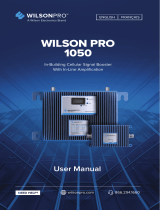
Advanced Test Products RG6-E
OPERATING YOUR RG6-E
Procedure for Normal System Recovery
1. Inspect the RG6-E thoroughly to insure that it is in good operating condition.
2. Connect the RG6-E to the service manifold and system as shown in figures on page
8. Make sure all hose connections are correct and tight.
3. Open the liquid port of the recovery cylinder (always open valves slowly to check
hoses and connections for leaks).
4. Make sure the Recover/Purge valve is set on Recover.
5. Open the Outlet port of the RG6-E.
6. Open the liquid port on the manifold gauge set; opening the liquid port will remove
the liquid from the system first, greatly reducing the recovery time (after the liquid
has been removed, open the manifold vapor port to finish evacuating the system).
7. Connect your RG6-E to a230V 50Hz outlet.
8. Switch the POWER switch to the ON position. This will start the compressor (it may
be necessary, under certain circumstances, to press this switch more than once to
start the compressor).
9. Slowly open the Inlet port on the RG6-E.
a) If the compressor starts to knock, slowly throttle back the Inlet valve
until the knocking stops (liquid hammering).
b) If the Inlet valve was throttled back, it should be fully opened once the
liquid has been removed from the system (the manifold vapor port
should also be opened at this time).
10. Run until your minimum required vacuum is achieved.
a) Close the manifold vapor and liquid ports.
b) Close the RG6-E Inlet port.
c) Shut unit off and proceed with the Self Purge procedure on the next
page.
11. Always purge the RG6-E after each use. Failure to purge the remaining refrigerant
from the RG6-E could result in the acidic degradation of internal
components, ultimately causing premature
failure of the unit.
CAUTION
When pumping liquid, do not allow the
RG6-E to operate with the Inlet valve
too far open, causing the compressor
to knock. Doing so may stall the
compressor.
* "$2'$3,(2-, 9 2*$4$*130% "$
-,,$"2 '-1$%0-+2'$(,*$21(#$-%2'$3,(22-
2'$*(/3(#.-02-%2'$1612$+!$(,&1$04("$#
-,,$"2 '-1$%0-+2'$-32*$21(#$-%2'$3,(2
2-2'$*(/3(#.-02-, 0$"-4$06"6*(,#$0
.$,2'$*(/3(#4 *4$-,2'$0$"-4$06"6*(,#$0
30,2'$0$"-4$0.30&$),-!2-
.$,2'$-32*$24 *4$-,2'$3,(2
-&&*$2'$.-5$015(2"'
3,2'$3,(23,2(*2'$#$1(0$#4 "33+(1
*-1$2'$(,*$2 ,#-32*$24 *4$1-,2'$3,(2
-&&*$2'$.-5$015(2"'
*-1$2'$.-021-,2'$0$"-4$06"6*(,#$0
Tech Tip
-0 % 12$00$"-4$06.0-"$#30$0$"-4$0%0-+!-2'
2'$*(/3(# ,#4 .-0.-021-%2'$1612$+!$(,&
1$04("$#!631(,& 2$$822(,&-0+ ,(%-*#& 3&$
set in the hose setup.
**-52'$12-0 &$"6*(,#$02-1(23,#(1230!$#%-0
'-3012- **-5 (02-0(1$2-2'$2-.
-,,$"2 + ,(%-*#& 3&$1$22-2'$"6*(,#$0
$ #2'$ +-3,2-%.0$1130$(,2'$"6*(,#$0 1
$2$0+(,$2'$ +!($,22$+.$0 230$(,2'$
$%$02- 0$%0(&$0 ,2.0$1130$2$+.$0 230$
"' 02 ,#8,#2'$ +!($,22$+.$0 230$$ #
"0 ")-.$,2'$4 .-0.-02
4 *4$'(1(1#-,$1*-5*62-" 31$ 1*(22*$
230!3*$,"$(,1(#$2'$"6*(,#$0 1.-11(!*$
2"'2'$.0$1130$-,2'$& 3&$#$"0$ 1$
-.0$4$,24$,2(,& ##7.1(2-2'$
.0$1130$1'-5,-,2'$"' 02'$,2'$& 3&$
**-52'$"6*(,#$02-1(2%-0+(,32$1 ,#2'$,
$.$ 22'$.0-"$11(%,$"$11 06
























